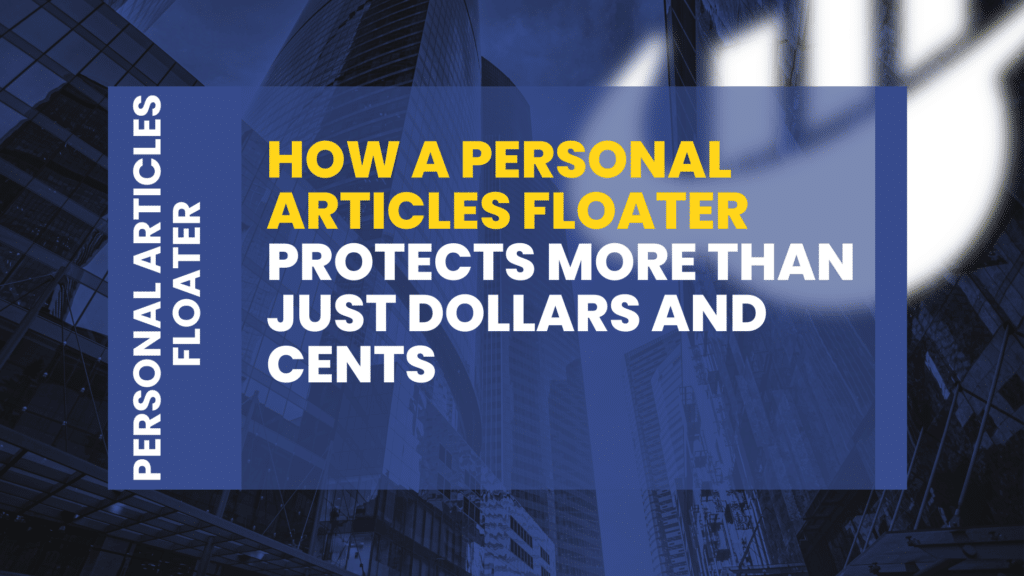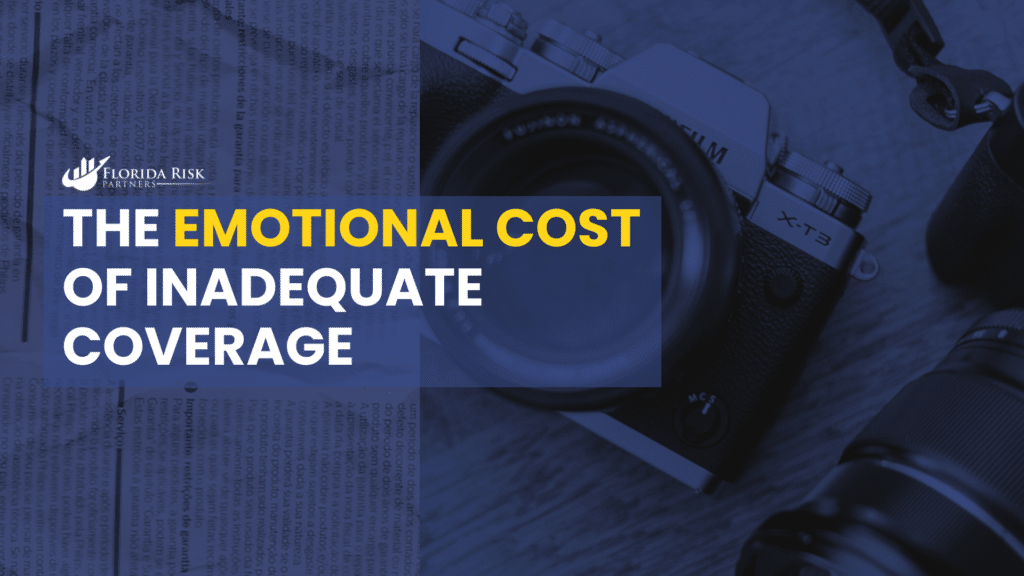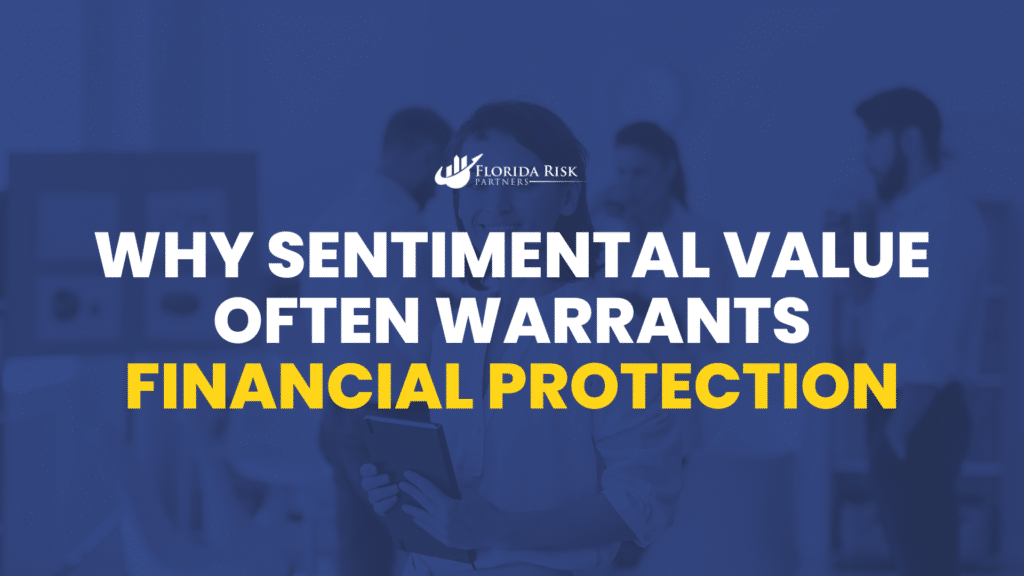-
Main Office: 1434 E. Bloomingdale Ave Valrico, FL 33596-6110
-
Phone: (888) 601-6660
-
Email: info@floridariskpartners.com

Insurance is often thought of in purely financial terms—dollar limits, deductibles, replacement costs, and claims checks. But if you’ve ever lost something truly special, you know the emotional cost of that loss can far outweigh the financial hit. Some items carry a significance that goes well beyond what you paid for them. They’re tied to stories, milestones, and people. They’re priceless not because of their market value, but because of what they represent.
This week, as part of our 12-part series on Personal Articles Floaters, we’re shifting our focus from the numbers to the meaning behind the items we protect. We’ll explore why insurance for valuable personal property isn’t just about replacement costs—it’s about honoring the memories and moments that live in the things we treasure most.
If you’ve ever wondered whether it’s worth insuring that ring your grandmother gave you, or that violin you’ve played since childhood, the answer lies in this deeper question: Can you afford to lose it emotionally, not just financially?
The Emotional Value of the Things We Own
Our possessions tell the stories of our lives. The watch your father wore every day before passing it down to you. The engagement ring you proposed with on a rainy night in Paris. The camera that’s captured every family vacation for a decade. These are more than “items”—they’re tangible connections to people, places, and memories that help shape who we are.
In the world of insurance, this intangible value is often overlooked. Most policies are structured around numbers: how much an item is worth, how much depreciation applies, what the payout limit is. But when a sentimental item is lost, stolen, or destroyed, the emotional toll can be overwhelming—especially if you find out after the fact that it wasn’t properly insured.
That’s why a Personal Articles Floater isn’t just a financial product—it’s an emotional safety net. It allows you to preserve not just what something costs, but what it means.
The Emotional Cost of Inadequate Coverage
Imagine this: your home is burglarized while you’re away on vacation. When you return, you realize your mother’s heirloom necklace is gone. You contact your insurance carrier, file a claim, and breathe a small sigh of relief, assuming you’ll be made whole. Then you find out your homeowners policy only covers $1,500 for all jewelry theft—and the necklace was worth $8,000.

Worse yet, the piece had never been appraised. You have no detailed photos. No floater. The claims adjuster offers you $1,200 after depreciation. Now you’re left not just with a financial gap, but with a deep emotional wound that’s compounded by the knowledge that you could have protected it better.
This scenario plays out far too often. People assume their standard coverage is enough—until it isn’t. The heartbreak of losing something meaningful is hard enough. Realizing that you could have done more to protect it only makes the pain worse.
Real-Life Stories That Illustrate the Point
Let’s look at a few real-life examples that highlight just how significant emotional value can be—and how a Personal Articles Floater can make a difference.
A Father’s Watch
Mark inherited a Rolex watch from his father, who had worn it daily for 30 years. To Mark, the watch was more than a timepiece—it was a legacy. After a house fire, the watch was destroyed along with several other valuables. Because he had scheduled the item on a Personal Articles Floater for $12,000, the insurer paid the full agreed value, allowing Mark to work with a watchmaker to restore a nearly identical model.
While the replacement could never replicate his father’s exact watch, it provided closure and helped Mark continue the tradition. Without that floater, he would have received less than $1,500 from his homeowners policy.
A Violin with History
Sarah had played the same violin since she was 10 years old. It wasn’t a Stradivarius, but it was special—handcrafted, gifted by her late grandfather, and central to her identity as a musician. One day, the violin was stolen from her car while traveling to a performance.
Fortunately, Sarah had listed the violin on her Personal Articles Floater for $7,500. The full amount was reimbursed, and she was able to purchase a nearly identical instrument from the same luthier who had built the original. Had she relied solely on her homeowners policy, she likely would have received only a few hundred dollars.
These stories aren’t about dollar figures—they’re about emotional recovery. And that’s what personal articles coverage is designed to support.
Why Sentimental Value Often Warrants Financial Protection
It may seem counterintuitive to think about placing a monetary value on something priceless, but that’s exactly why a Personal Articles Floater matters. It gives you the chance to proactively assign value to things you couldn’t easily replace.
Here’s why that’s important:

- Replacement Options Matter: If something is lost or damaged, a floater ensures you have the funds to seek a similar item, restore a damaged one, or at the very least, preserve the memory in a tangible way.
- Fewer Claim Disputes: Scheduling an item on a floater eliminates questions about whether it was covered, what it was worth, and how depreciation should apply. The terms are agreed upon up front.
- Protecting Legacy: When you schedule sentimental items—especially heirlooms—you’re protecting a legacy for the next generation. It’s not just about your peace of mind; it’s about what you pass on.
- Avoiding Regret: Many people only learn about insurance gaps after a traumatic event. Taking the time to float meaningful items ensures you won’t face that regret later.
How to Identify Items with Sentimental Value
If you’re wondering whether you own anything that fits this category, here’s a simple exercise: walk through your home and ask yourself which items would hurt to lose—not because of cost, but because of connection.
Look for:
- Gifts from loved ones
- Family heirlooms
- Items tied to life milestones (engagement rings, diplomas, instruments)
- Items with personal stories (souvenirs from meaningful trips, handwritten letters in lockets, passed-down tools or kitchenware)
Once you’ve identified these items, ask yourself:
- Do I know their current value?
- Do I have documentation or photos?
- Are they covered in full under my homeowners policy?
- Would I want the option to replace or restore them if they were lost?
If the answer to the last question is yes, then a Personal Articles Floater is likely a good idea.
Getting Started: Documenting the Emotional and the Valuable
You don’t need to schedule every item you care about. But for the ones that truly matter—emotionally and financially—it’s worth taking a few proactive steps.
Here’s how to start:
- Make a List: Identify items with sentimental value and/or high financial value.
- Take Photos: Clear images help in both claims and appraisals.
- Collect Receipts or Appraisals: Especially for jewelry, art, or collectibles.
- Create a Short Note: For heirlooms or sentimental pieces, write a quick paragraph about the item’s story. This can be helpful for family discussions and claims handling.
- Talk to Your Insurance Agent: Review your current coverage, identify any gaps, and schedule the items that qualify.
To help with this process, we’ve created a free downloadable checklist and inventory template to walk you through each step.
The Bottom Line: Insurance That Honors What You Value Most
At the end of the day, insurance is about protection. But it’s also about respecting what matters to you. Whether it’s a ring, a watch, a violin, or a book of old love letters, personal property tells the story of who we are. Protecting those items with a Personal Articles Floater isn’t just smart—it’s deeply meaningful.
A floater bridges the gap between what something costs and what something means. It gives you the ability to recover not just financially, but emotionally, and that’s a kind of value that’s hard to measure—but easy to appreciate when the unexpected happens.
Ready to Protect What Matters Most?
If this post made you think of one or two items you’d be devastated to lose, now is the perfect time to act. Take the next step toward peace of mind:
Stay tuned for next week’s blog post, where we’ll share real-life claims scenarios that demonstrate just how critical it is to have the right personal articles coverage in place.
Let’s protect what matters—together.
Call Us Or
Schedule an Appointment
Select an agent below to view our online calendars and select a day and time that works best for you or call us directly at 888-601-6660. When you use our online calendars, you will receive an email with more information.



